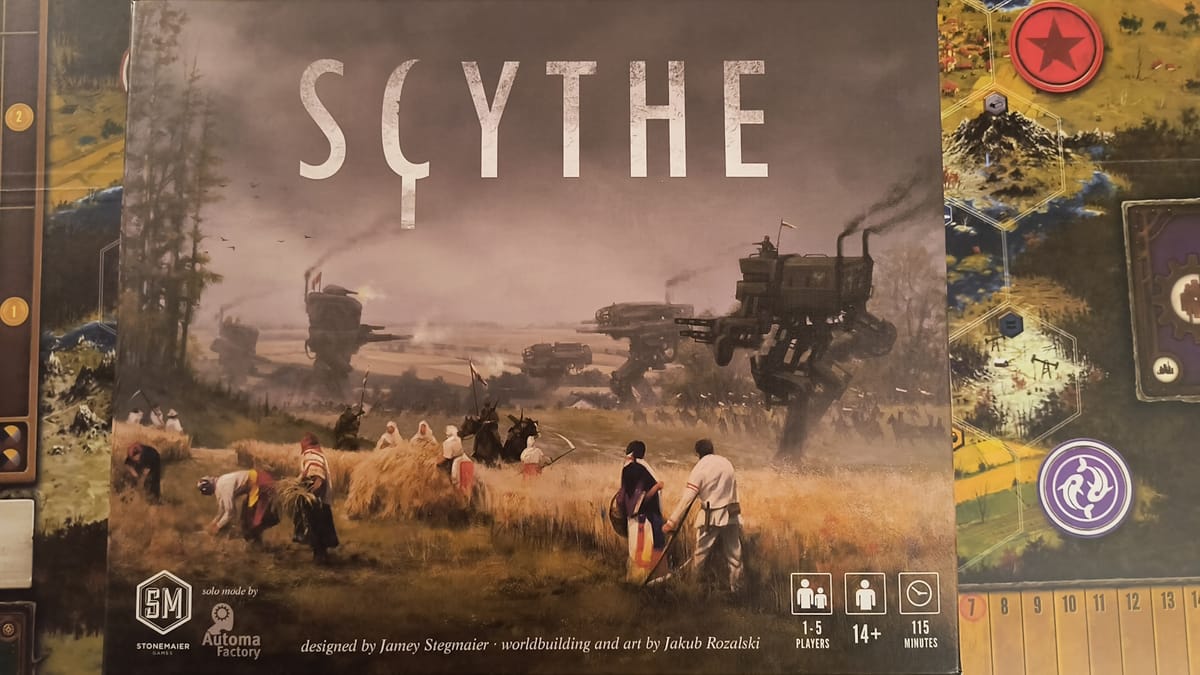
A diesel powered mech crunches through a pastoral field in the distance, smoke pouring from the artillery mounted to its chassis. In the foreground, a group of farmers continue working their fields, though the worry on their faces from the nearness of the war is apparent. You’ll find this scene, and many, many more in Scythe, a game that acts as a showcase of both the art of Jacub Rozalski and the mechanical design chops of Stonemaier games.
Released in 2016, Scythe is a 1-5 player area control game where the economy takes the front seat. Players will use diesel punk mechs in a World War 1 era world to expand into an alternate history Russia. Workers will gather resources, then mechs will transport those workers and go to war with each other, and heroes will explore the map and interact with its inhabitants. The map is centered on the former city state known as the Factory, whose technological advancements have changed the world in dramatic ways, though they’ve since mysteriously abandoned their capital city.
To play, each player will take turns choosing a pair of actions on their action board. Each action board is unique in that the pairs of actions are different for each player. There are always the same four top row actions and the same bottom row actions, but each board shuffles them up and changes the incentives for each action board. The top row actions are all things you do to get ahead, like producing resources on tiles where you have workers, moving units around the board, or gaining power, favor, or resources you may not have access to.
The bottom half of the board all has to do with pursuing victory conditions and increasing your efficiency. Each bottom row action requires resources produced by your workers: oil, iron, wood and food, and results in a powerful benefit for your faction. In order, they are upgrading your action board, building a mighty mech, building a landmark building, or conscripting a recruit. Each of these actions makes your faction more powerful, and also might pay out money depending on which action board you have. Money is important, it’s required for many actions, but each coin is also one point closer to victory.
The game ends when one player puts out their 6th achievement star. This means that only one player will have all six stars on the board, which is a powerful advantage. Other players will have to hope that they’ve earned enough points another way. Achievements are given for accomplishing several different things, such as building all 6 upgrades, deploying all 4 mechs, recruiting all 4 recruits, or building all 4 buildings, as well as getting all workers onto the board, accomplishing a secret objective, winning up to 2 battles, or maxing out favor or power.
The tactical side of things is perhaps the most rule intensive part. Everything above is pretty straightforward once you start playing. However, movement can get fiddly. It works well once you get a hang of it, though. The hero can move and fight, gains the benefit of any unlocked mech ability, and can make use of exploration tokens which provide riches based on a decision on a card. Mechs can move just like a hero and can also take any number of workers along for the ride, but they cannot take advantage of exploration tokens. Mechs are important, even for players who don’t intend to fight at all. They allow players to quickly move their workers to where they’re needed to do what they want to do. Workers are also usually more limited than mechs in their movement capabilities.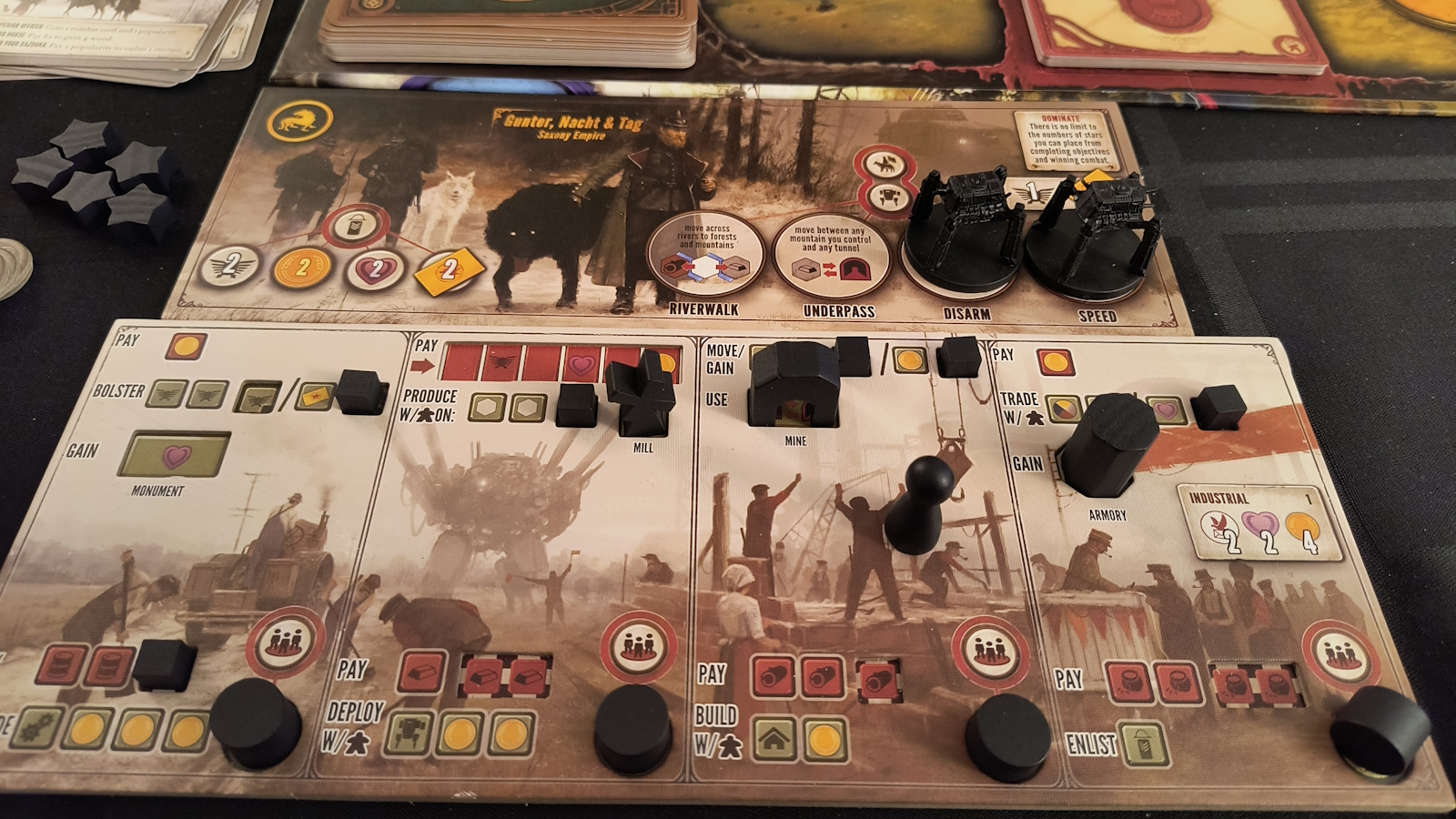
The field is split apart by rivers everywhere. Each faction will only have access to 3 tiles initially and must find a way across the river to proceed. The game offers a few options, such as deploying the mech with the Riverwalk ability or to build a mine that connects to pre-built tunnels spread across the map. Riverwalk is one of those fiddly abilities I mentioned as each faction has their own version of Riverwalk, which lets them cross rivers into 2 specific tile types. While this is awkward, it is vital to understand as it can mean the difference between safety and being one turn away from someone stealing your resources. Other factions might have alternate abilities to cross the rivers, such as Red’s ability to move directly from towns to the factory or blue’s ability to have workers swim across the rivers.
Once a player has all of their stars out, the game ends, and players get points based on the favor they had at the end of the game. They get one more point per star, hex, and pairs of resources they have at the end of the game per tier of favor they possess. This makes favor an extremely potent resource as well, but you’ll be spending it throughout, either on the best rewards for exploration or for end game production actions.
Each of these systems works together in a potent blend to make each action feel impactful. Each person can, and will, have a very different strategy in Scythe. Some players will rush getting stars out, ending the game as soon as possible with them hopefully having the stars they need to win. Others might use a powerful combo to earn coins during the game and only receive a few benefits at the end game scoring. Still, others might bully their way across the table, disrupting other players’ strategies and earning many of their stars that way. The thing is, in my games playing Scythe, I’ve seen each of these strategies win! 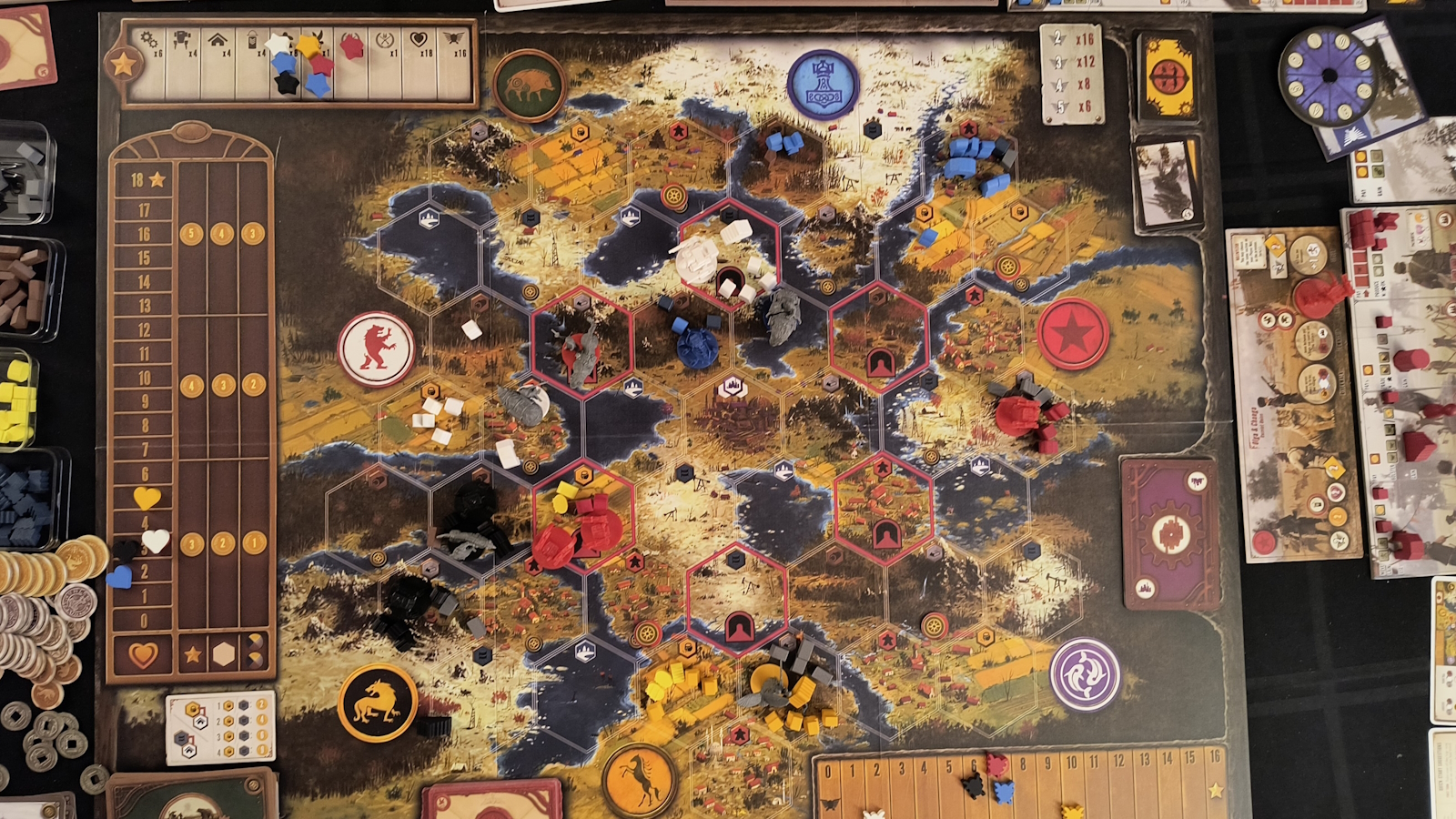
Scythe feels like an epic strategy game, but only takes about 2-3 hours to play. Each faction feels unique while being mostly balanced. The most variance offered is in objective cards, which do not have to be completed, and in exploration cards, which, at the very least, always offer something you want. While there is no trade with opponents, there is still plenty of political tabletalk. Especially when it comes to one player getting 1 or 2 stars away from ending the game.
The end game is very tense in Scythe. Scythe is one of those games that goes from very breezy, with each player taking actions quickly, to very methodical, with each action weighed very carefully to be the most optimal. This is because the game has an almost exponential decision space. You go from very simple turns at the start, managing your tiny empire, to managing 8 workers, 3 mechs, and dealing with friction on all sides from your opponents.
It’s not all perfect. While I adore most of the game, the hidden objectives are definitely hit-or-miss. You get two and complete either, which is good, because about half of them (or so it seems) are going to be impossible for you during your game. Some of them are easy to lock yourself out of, such as building all of your workers without building a single mech, or getting all of your mechs out without building a single extra worker. Others are simple, such as holding onto 3 tunnel tiles, which is extremely easy since they all connect to each other. This weird dichotomy of impossible and too easy makes them a free star for some people at the table and impossible for others. While Scythe never promised to be perfectly balanced, this one thing still feels very unfair at times.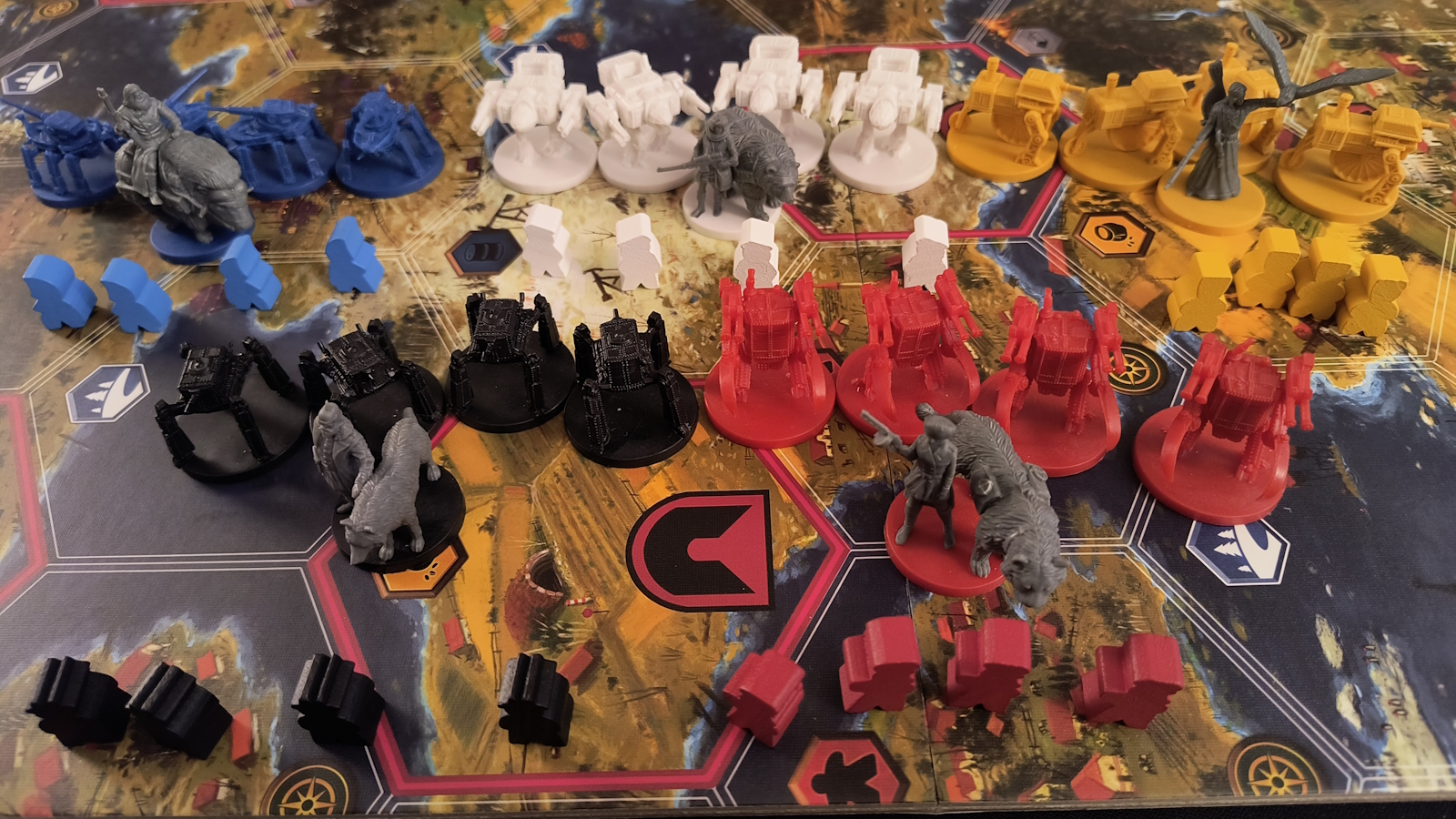
Certain faction and action card combinations also feel either very powerful or very weak. The game flat out bans 2 combinations in the rulebook as they have obvious problems (one gives a guaranteed 2 coins each turn with no downside, for example). However, I also feel like being the faction that can get unlimited stars from winning fights, and getting the action board that entices you to build and enlist (which doesn’t have anything to do with fighting), can be a little disheartening. You either play unoptimally or ignore a part of what makes your faction unique. On the other hand, there are action boards that put their high-value play on the trade or produce top action, meaning you just keep taking that action whenever you can to earn money.
However, despite this, it’s just a fun game to play. And I would be lying if I said a large part of that wasn’t Jakub Rozalski’s art in the game. His depictions of pastoral scenes dominated by diesel-punk mechs and other fantastic weapons of war makes each card pop, especially on the exploration cards. The art on the cards is reproduced by the plastic pieces on the board, which are lovingly detailed. Each faction has their own unique mechs, which range from scythe toting farming mechs that have clearly been repurposed to war, to four legged weapon emplacements that move. These each echo the abilities that the factions have, such as the blue mechs looking like walking boats (blue can unlock the ability to float across lakes, and their workers can swim across rivers), or yellow’s battle ready mechs that look like tanks with legs.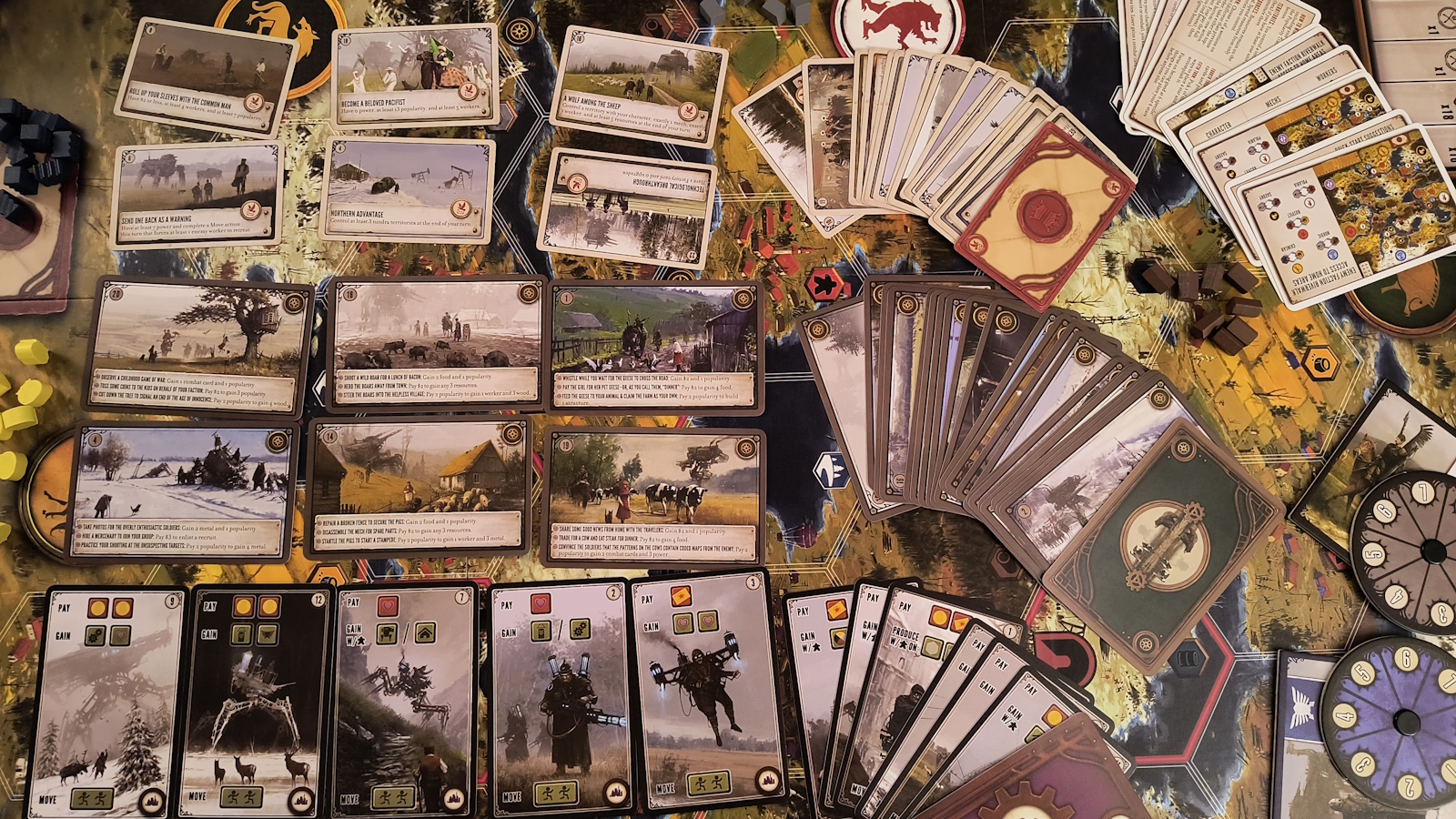
For those who want more out of the game, Scythe has a large number of expansions, such as increasing the number of encounter cards, adding new factions, adding a whole new unit type (airships, which look cool) and even a full on legacy campaign. There’s also going to be a sequel soon, called Expeditions.
Scythe’s large box and massive table presence definitely gives off “you’re gonna be here for a while” vibes. It certainly was a major reason I avoided the game for so long. However, Scythe is actually a very quick moving game, and while 2 hours might sound like a long time for some board games, it feels just right in Scythe. The achievement system means that no matter which path to victory you take, you’re going to end the game just as you are starting to run out of things to do. It’s finely tuned in a way that few board games are, with just enough fiddly fuzzy bits to make it interesting every time. Scythe has earned a long-term spot on my gaming shelf.
Scythe
Excellent
Scythe is a pre-World War I era diesel-punk game with massive mechs. Use workers, gather resources, upgrade your stuff, and fight each other. A game that stays interesting throughout its 2-3 hour play time. Has some of the best art and components around, even without the expansions.
Pros
- Each faction feels unique and has lovely components to sell their unique aspects.
- The art of Jakub Rozalski is at once gorgeous and strangely alien, and brings the experience together.
- Each game is close, tense, and fun.
Cons
- A huge table hog, even more so with the expanded board.
- Some board combinations feel less exciting than others.
- Objective cards range from nearly free to nearly impossible.
